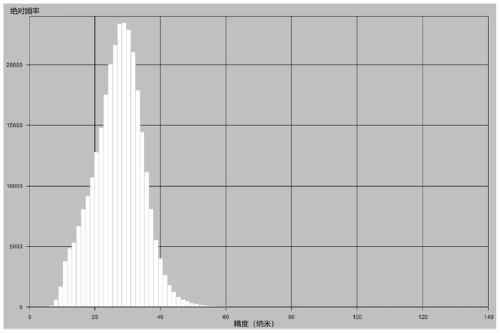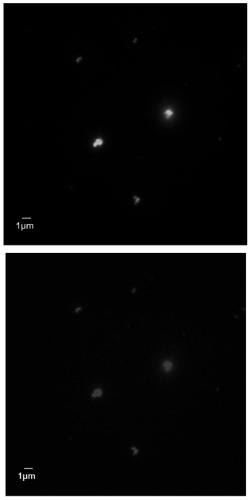Preparation method and application of super-resolution imaging probe based on silicon dioxide
A super-resolution imaging, silicon dioxide technology, applied in the analysis of materials, material excitation analysis, material analysis by optical means, etc., can solve the problems of microscopic world imaging that cannot be smaller than 200 nanometers, and achieve excellent scintillation characteristics and high positioning accuracy. , The effect of the simple preparation method
- Summary
- Abstract
- Description
- Claims
- Application Information
AI Technical Summary
Problems solved by technology
Method used
Image
Examples
Embodiment 1
[0041] Dissolve 9.1mg of L-arginine in 6.9mL of deionized water, mix well, add 450 μL of cyclohexane to the solution, heat the reaction bath at 60°C on a heating platform, then add 550 μL of TEOS, 60 temperature water bath and stirred for 20 hours, the resulting solution is the silica nanosphere solution (the total concentration of silica is 20mg / mL).
[0042]Take 1 mL of the silica nanosphere solution and centrifugally purify it into 1 mL of ethanol, and then add 5 μL APTMS to obtain an aminated silica nanosphere solution. Centrifuge and purify into 1 mL of ethanol, then add 2 μL of 1 mg / mL Alexa Fluor647 NHS ester, react in a shaker at room temperature for 12 hours, and purify the sample 6 times at 18000 round / min for 25 min to obtain Alexa Fluor 647 silica nanospheres. Subsequently, 330 μL of the silica nanosphere solution mixed with Alexa Fluor 647 was added to 3.3 μL of 10% (v / v) glutaraldehyde solution, and the reaction was shaken on a shaker at room temperature for 0.5...
Embodiment 2
[0046] Dissolve 9.1 mg of L-arginine in 6.9 mL of deionized water, mix well, add 450 μL of cyclohexane to the solution, heat the reaction bath at 60°C on a heating platform, and then add 550 μL of TEOS, 60 temperature water bath and magnetically stirred for 20 hours, the resulting solution was the silica nanosphere solution (total silica concentration 20 mg / mL).
[0047] 1 mL of the silica nanosphere solution was centrifuged and purified into 1 mL of ethanol, and then 7 μL of APTMS was added to obtain an aminated silica nanosphere solution. Centrifuge and purify into 1 mL of ethanol, then add 3 μL of 1 mg / mL AlexaFluor 647 NHS ester, react on a shaking table at room temperature for 16 hours, and purify the sample 6 times at 18,000 round / min for 30 min to obtain Alexa-incorporated Silica nanospheres of Fluor 647. Subsequently, take 330 μL of the silica nanosphere solution mixed with AlexaFluor 647, add 16.5 μL of 10% (v / v) glutaraldehyde solution, and shake the reaction at roo...
Embodiment 3
[0049] Dissolve 9.1 mg of L-arginine in 6.9 mL of deionized water, mix well, add 450 μL of cyclohexane to the solution, heat the reaction bath at 60°C on a heating platform, and then add 530 μL of TEOS, 60 ℃ constant temperature water bath and stirred for 24 hours, the resulting solution is the silica nanosphere solution (the total concentration of silica is 19 mg / mL).
[0050] 1 mL of the silica nanosphere solution was centrifuged and purified into 1 mL of ethanol, and then 6 μL of APTMS was added to obtain an aminated silica nanosphere solution. Purify by centrifugation into 1 mL of ethanol, then add 2 μL of 1 mg / mL AlexaFluor 647 NHS ester, react in a shaker at room temperature for 12 hours in the dark, and purify the sample 6 times at 18,000 round / min for 30 min to obtain Alexa-incorporated Silica nanospheres of Fluor 647. Subsequently, take 330 μL of the silica nanosphere solution mixed with AlexaFluor 647, add 3.3 μL of 10% (v / v) glutaraldehyde solution, and shake the r...
PUM
| Property | Measurement | Unit |
|---|---|---|
| diameter | aaaaa | aaaaa |
| diameter | aaaaa | aaaaa |
| size | aaaaa | aaaaa |
Abstract
Description
Claims
Application Information
 Login to View More
Login to View More - R&D
- Intellectual Property
- Life Sciences
- Materials
- Tech Scout
- Unparalleled Data Quality
- Higher Quality Content
- 60% Fewer Hallucinations
Browse by: Latest US Patents, China's latest patents, Technical Efficacy Thesaurus, Application Domain, Technology Topic, Popular Technical Reports.
© 2025 PatSnap. All rights reserved.Legal|Privacy policy|Modern Slavery Act Transparency Statement|Sitemap|About US| Contact US: help@patsnap.com



